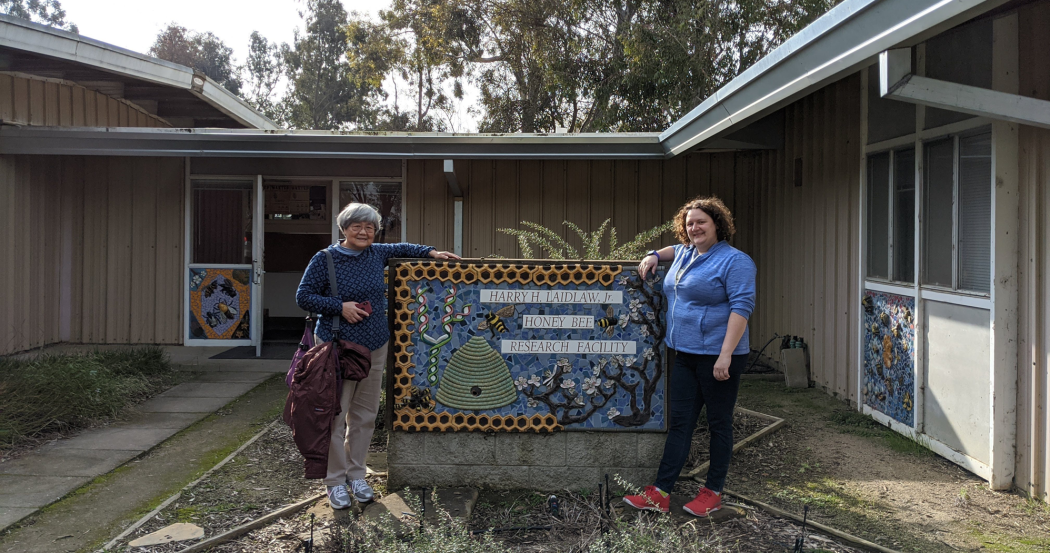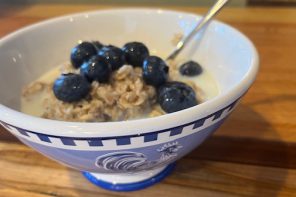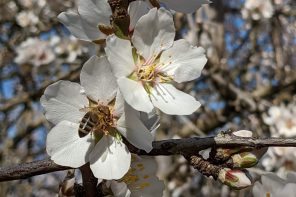Bee Research and Extension Programs at University of California, Davis: The Early Days
The UC Davis Series
By: Elina L. Niño
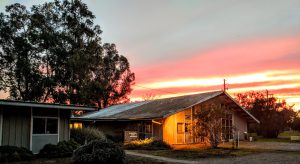
Laidlaw Bee Facility
Named after the “father of honey bee genetics” Dr. Harry H. Laidlaw Jr., the Bee Research Facility is a part of a larger, as I like to refer to it, Bee Complex located only a few miles away off of Central UC Davis Campus (West of Route 113 for those who might be familiar with the area). The Bee Complex is composed of the Bee Facility, UC Davis Bee Haven garden, a number of smaller research plots, several ancillary buildings for storage and most recently, a set of mobile trailers housing the Davis USDA Bee Lab. But as you know, it is the people that really make the program, and our program at UC Davis is a home to a number of researchers and extension specialists contributing to bettering bee health. This series aims to showcase all of the great work being done by the UC Davis Bee Program teams. But first, a little bit about our history!
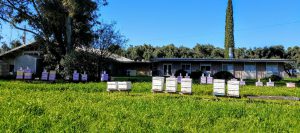
The Bee Facility Apiary
While you have likely heard of the Bee Program at UC Davis, you probably don’t know that its impressive history began long before many of us reading this issue of Bee Culture were even born. It is my pleasure to take you on a brief journey of the establishment of the UC Bee Program, as it has been shared with me by the late Robbin Thorp and Eric Mussen (to read a more detailed history written by Kathy Keatley Garvey, please visit https://ucanr.edu/blogs/blogcore/postdetail.cfm?postnum=39191). Lastly, I will briefly introduce you to the current faculty members and their respective research and education programs, which we will expand on in the upcoming 2024 issues of Bee Culture. Many well-known and well-respected researchers and educators have conducted seminal works while at UC Davis. They helped make the UC Davis Bee Program what it is today and my current colleagues and I are eager to carry that legacy into the future. My hope is that you will enjoy reading this series as much as we are enjoying writing it for you.
The People: Early 1900s to Early 2010s
Let me take you back to the early 1900s (yes, I just said that, and yes it makes me feel old as well!), when George Haymaker Vansell (1892-1954) was a student at UC Davis. His interest in insect science led him to become the first instructor to teach an Entomology and Apiculture course at UC Davis from 1920 to 1931, highlighting the need for formal Entomology education. He was titled an Instructor in Entomology while also holding a position as a USDA employee at the Davis Experiment Station. Vansell was particularly interested in the field of plant-insect interactions, and has published a number of bulletins concerning honey bee forage. As avid beekeepers, most of you have probably heard at some point that honey bee colonies can suffer poisoning when foraging on California Buckeye (Aesculus californica). Vansell’s interest in this phenomenon resulted in several publications in which he discusses the symptoms of buckeye poisoning, and together with his colleagues, offers possible solutions for reducing damage to colonies. His work suggests that adult worker bees were usually not detrimentally affected; therefore, creating small colony units containing only adult workers and one frame of brood can lead to production of buckeye honey while simultaneously preserving some of the colony work force if the honey is extracted in a timely manner. Vansell and Todd also suggest that Italian x Carniolan hybrids faired a bit better during the production of the buckeye honey as compared to Italian x Caucasian hybrid colonies, but neither had successful recovery. Interestingly, throughout these research articles there is regular mention of the bears destroying colonies in the Sierra Nevada foothills, much like the beekeepers today still have to deal with these intruders. Prior to his sudden passing in 1954, Vansell had also completed research on fruit tree and seed crops pollination. A scholarship established in his honor has helped support many bee students in their fervent effort to advance the field of apiculture.
Around the same time period, Frank Edward Todd (1895-1969) served as the USDA apiculture research branch head at the USDA Pacific States Bee Culture Laboratory at UC Davis (1931-1942). He collaborated closely with Vansell on projects dealing with honey bee poisonous plants, and has advanced pollination of many crops including seed alfalfa, cantaloupes and tangerines. Perhaps most notably, he has reported observations of honey bee nectar collection on alfalfa and the, now well known, tripping mechanism of the alfalfa flower during attempted foraging by honey bees. While affiliated with the UC Davis Bee Biology Program, he modified the dead bee trap originally designed by Norman Gary, which is known as the “Todd Dead Bee Trap”, and has been used in research on effects of various chemicals on bee mortality. Another USDA apiculturist worth mentioning was Edward Lloyd Sechrist (1873-1953). While working in the USDA Office of Bee Culture, he collaborated with researchers at UC Davis Bee lab on several projects that have included honey gathering and daily colony weight changes due to nectar collection. His most notable contribution to the field of apiculture is the proposition for United States standards for honey in 1927.
You probably noticed that the first researchers conducting honey bee and pollination research at UC Davis were actually most directly associated with USDA. However, in 1931, UC Davis hired John Edward Eckert (1895-1975) as a Professor of Entomology and Apiculture, who also served as the Department Chairman from 1934 to 1946. Eckert is well known for studying the flight range of honey bees and he reported extensive observations on this topic including the observation that honey bees prefer to stay close to the apiary in search of forage, but will fly up to 8.5 miles to the food source if necessary. Honey bee resource constancy was also noted by him. Eckert (affectionately called Eck by his peers and stakeholders) was well respected among beekeepers as he supported their efforts to protect colonies from pesticides, and has completed research on potentially harmful pesticide effects on colonies. He is also credited with pioneering antibiotic use in honey bee colonies for management of bacterial diseases, and spent time in Australia and Europe researching various ectoparasitic mites on honey bees including Tracheal mites (Acarapis woodi). Very apropos to this article, Eckert spent decades as the editor of the California column in Gleanings in Bee Culture. Among his many extension publications is the first edition of the Beekeeping in California, Circular 100 from 1936, which has been updated over the years and is still used by many.
As mentioned before, the facility that is still being used by the Bee Program faculty, has been named in honor of Harry Hyde Laidlaw, Jr. (1907-2003) who joined UC Davis as a Professor of Apiculture in 1947. Laidlaw’s research studying mutations leading to differences in eye color, pigment-free blind drones, differences in wing length, hairlessness and resulting identification of underlying molecular and biochemical pathways, have earned him an unofficial title of “The Father of Honey Bee Genetics”. Arguably most impactful applied technology development, however, was the development of the first functional instrument for insemination of queen honey bees. This was made possible by Laidlaw’s study of the queen morphology, and subsequent realization that the only way the queen can be successfully instrumentally inseminated is if the valve-fold is held away from the median oviduct opening. His discovery has provided the means for successful bee breeding and has revolutionized the beekeeping industry. Northern California bee breeders still speak very fondly of Laidlaw. Speaking to his aptitude for innovation and leadership was his selection as the first Dean for Research in the College of Agriculture at UC Davis. He published several seminal queen rearing and bee breeding books, including my personal favorite Queen Rearing and Bee Breeding, written in collaboration with Robert Page, another alumni of our Bee Program. Lastly, in addition to the Bee Biology Facility being named after him, the Laidlaw family established an endowment in his name and in support of student research.
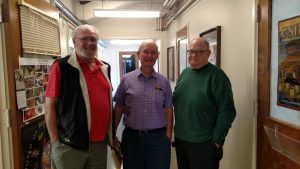
Robbin Thorp, Norm Gary, Larry Connor at the Bee Facility in February 2016
Fifteen years later, Norman E. Gary joined UC Davis as a Professor of Apiculture with special interest in studying honey bee foraging behavior and mating behavior of queens and drones. He was the first to identify queen mating pheromones, and to observe and describe aerial mating of queens and drones. During the medfly eradication efforts by California Department of Food and Agriculture, Gary began studying the impact of pesticide applications on honey bee health, which led to his design of the dead bee trap, later modified by Todd. Gary is also well known for his contributions to the film industry as he has been an adviser on sets of movies such as “Fried Green Tomatoes”, “My Girl” and “Candyman”, earning him the nickname “The Bee Wrangler”. He even has his own IMDb page. Gary has been retired since 1994, but he still occasionally visits the Bee Facility and even borrows bee colonies for small behavioral experiments. Much like his contemporaries Robbin Thorp and Eric Mussen were not, Gary is not very good at being “retired”, and has since published another one of my favorite book recommendations Honey Bee Hobbyist: The Care and Keeping of Bees (I have been lucky enough to have him sign my copy!).
Joining forces with Laidlaw and Gary, Ward Stanger (1913-2000), an extension apiculturist quickly became a champion for the beekeeping industry. In the late 1960s and early 1970s he published extension works discussing the beekeeping industry in California, and comparing the bee breeding and queen rearing efforts in Northern California versus southeastern Gulf States. Stanger understood the value of optimal nutrition to bee health and need for pesticide protection, readily urging the U.S. government to allow for forage access and stricter pesticide regulations. He has also published recommendations for supplemental feeding of colonies to increase their productivity, and a manual on how to remove honey bees from structures.
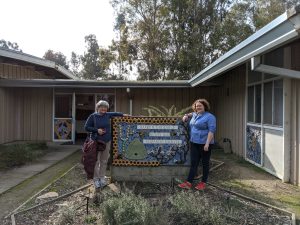
Christine Peng and Elina L. Niño, January 2020
In 1975, Christine Y. S. Peng joined the Entomology Department as the Professor of Apiculture specializing in insect physiology. I am sure that at this point many, if not all of you, are aware that antibiotics for management of honey bee bacterial diseases require a prescription from a veterinarian. But I bet you did not know that Peng was instrumental in selecting tylosin as a possible replacement antibiotic for oxytetracycline hydrochloride (Terramycin®) since Paenibacillus larvae started developing resistance to it. Peng has also made invaluable contributions in elucidating gamete physiology laying groundwork for successful cryopreservation of honey bee genetic material. Her research into honey bee nutritional needs has led to guidelines for seasonal feeding regimes, and her interest in parasitology has led her to explore varroa mite physiology and various management strategies.
I am pretty certain that Robert E. Page Jr. and his seminal works in honey bee genetics don’t need much of an introduction to the readers of Bee Culture. Page joined the Department of Entomology faculty in 1989 where he also served as the Department Chair. There is not enough space here to write about his many research accomplishments so I invite you to read some of the hundreds of scientific articles or the four books that he has published thus far. His published works report on fundamental discoveries in honey bee behavior particularly regulation of foraging behavior, population genetics and the evolution of complex social behavior. Despite all his achievements and accolades he remains a refreshingly approachable colleague. His passion for honey bees particularly shines through in one of his latest projects “The Art of the Bee” YouTube channel (https://www.youtube.com/@artofthebee).
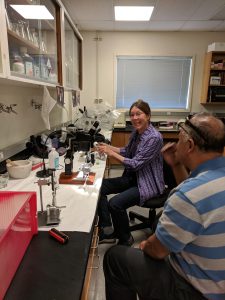
Sue Cobey, March 2018
The Bee Program can’t really be talked about without mentioning the contributions of Susan Cobey who was at UC Davis from 2007 to 2012. Cobey is a giant in the field of honey bee breeding and has worked tirelessly for decades to maintain and improve quality honey bee stock in close collaboration with the Northern California Bee Breeders. As a young eager doctoral student just discovering my interest in honey bee queen mating physiology, I deeply valued the opportunity to take the world-renowned Instrumental Insemination (II) course with Cobey while she was still working at UC Davis. Principles of II and many tips and tricks shared with me by Cobey are something I now share with the students in our own II courses. Her sustained efforts to improve the bee stock in the U.S. have led to the establishment of the New World Carniolan Breeding Stock that can be purchased from Northern California bee breeders.
Back in 2014, I joined the Department of Entomology and Nematology at UC Davis as the Extension Apiculturist, and to my delight I was able to spend a significant amount of time in the company of two great pollinator researchers and educators: Robbin W. Thorp (1933-2019) and Eric C. Mussen (1944-2022).
Thorp (To read more about R. W. Thorp, visit: https://ucanr.edu/blogs/blogcore/postdetail.cfm?postnum=30459) joined UC Davis as a Professor of Apiculture in 1964 and his research interests were in pollination behavior of honey bees particularly in almond production. Later on, he shifted his focus to non-Apis bees with emphasis on bee systematics, bee conservation and pollination of vernal pool plants. Bumblebee conservation efforts have been in large part inspired by Thorp’s research and he is cited as the main catalyst for successful petition for listing rusty patch bumblebee as an endangered species. Even though he retired in 1994, Thorp continued to come to work at the Bee Facility every day and continued to work on several projects. I have to specifically recommend two books he co-authored in his retirement: Bumble Bees of North America: An Identification Guide and California Bees and Blooms, a Guide for Gardeners and Naturalists. I am forever grateful to him for his guidance and advice, and for not minding me asking him a million questions while he was patiently identifying drawers-full of pinned bees for dozens of student and postdoc projects.
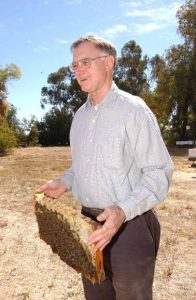
Eric Mussen – Photo by Kathy Keatley Garvey
Similarly, I will forever harbor deep gratitude and appreciation for Eric C. Mussen (To read more about E. C. Mussen, visit: https://ucanr.edu/blogs/blogcore/postdetail.cfm?postnum=52399). He joined University of California Cooperative Extension in 1976 and quickly became a go-to person for the beekeeping industry in California. As he spent more time immersed within California beekeeping, many others such as government entities, non-profit organizations, commodity boards became reliant on him for scientific and practical information. In collaboration with other UC Davis bee researchers, he conducted applied studies immediately relevant for the contemporary beekeeping industry. Shortly before I came to the University, Mussen retired in 2014. I will always be grateful to him for introducing me to the California beekeeping community, for offering guidance, and persistent willingness to give advice while making sure I become fully integrated within the California beekeeping industry.
It was truly my great honor and privilege to learn directly from two great bee researchers and educators. There is absolutely no replacement for their innovation and ingenuity in tackling challenges plaguing bee health, and I only hope I can serve California stakeholders as well as they have. They are very missed!
The People: 2010s to Today
Currently, the Bee Program in the Department of Entomology and Nematology has three core faculty members charged with conducting research and formal and informal education on bee biology and health. Neal M. Williams joined the department in 2009 where he continues working on wild bee biology, native bee conservation and pollination biology. He is devoted to developing supplemental forage mixes to enhance nutrition of all bees in agricultural landscapes of California, as well as modeling potential risks and benefits to bees within California lands. Brian R. Johnson joined the department in 2012 with a strong background in bee behavior. At UC Davis, he continues to study the genetic basis of bee behavior, bee defenses, impact of number of stressors on bee health, spread of Apis mellifera scuttelata hybrids within California, and occasionally conducts projects involving other insects. Most recently, he has published a book Honey Bee Biology which is bound to become a staple reading for beekeepers and researchers alike, and his second book should be coming out soon, so keep an eye out for it. I joined the department as an extension apiculturist in 2014, and learned quickly that I still have much more to learn. California beekeeping is not for the faint of heart and I am really grateful for the super supportive California beekeepers whose backing has allowed me to develop my research and extension program to an advanced level. My team and I conduct research that is directly applicable to beekeepers, including varroa mite management, improved nutrition and enhanced crop pollination. Extension activities are done by all members of my team and they range from offering beekeeping courses and giving club presentations through the California Master Beekeeper Program, all the way to offering technical services such as bee testing and colony inspections through newly established UC Davis Bee Health Hub. Several other of our UC Davis colleagues conduct bee research and we often collaborate with Rachel Vannette and Santiago Ramirez, as well as the two new USDA Bee Researchers Arathi Seshadri and Julia Fine.
Thank you for letting me take you on this short, yet (you hopefully agree) impressive journey through the history of UC Davis Bee Program. Make sure you stay tuned for the next articles in this UC Davis series, and with the upcoming start of pollination season it seems only appropriate to continue with an article delving deeper into some of the bee health and crop pollination research being done in the E. L. Niño Bee Lab. “See you” next month!






